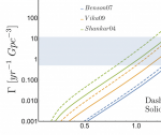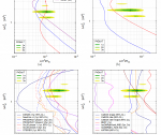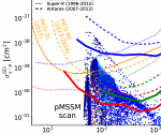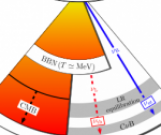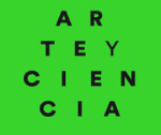Articles & Interviews
- 11/10/2017Dark Matter Day was organized at KIT on October 30, 2017
- 28/09/2017The event was co-organized by the Instituto de Física Corpuscular (IFIC, CSIC-UV), Príncipe Felipe Science Museum, and the European Union through various research grants (FUNDAMENTALCONNECTIONS, InvisiblesPlus RISE and Elusives ITN)
- 22/09/2017Andrea Caputo discussed the “Thermal History of the Universe” and “Matter-Antimatter Asymmetry” in his talks aimed at both researchers and students. The two one hour seminars took place at the University of Calabria on September 26, 2017 and September 27, 2017.
- 19/09/2017Paper of the month: Primordial-black-hole mergers in dark-matter spikesOn September 14, 2015, the two detectors belonging to the Laser Interferometer Gravitational-wave Observatory (LIGO) independently observed gravitational-waves from two merging black holes [1]. The existence of gravitational-waves was originally postulated by Albert Einstein in 1916 as a necessary consequence of his General Theory of Relativity. Despite search efforts spanning nearly 50 years, this was the first ever detection of gravitational-waves; and also the fi rst ever detection of a merging black hole binary, making this a monumental occasion in world of physics.
- 04/09/2017Professor Laura Baudis gave a talk at TEDxCERN -event on November 5, 2016.
- 22/05/2017Paper of the month: On the LHCb flavour anomaliesRecent results by the LHCb experiment provide a pattern of possible deviations from Standard model predictions in the decays of b hadrons mediated by the b → sl+ l− transition, which occurs through loop diagrams with high sensitivity to New Physics. They presented their results on the measurement of the quantity RK∗ = Br(B→K∗ µ+µ−) Br(B→K∗ e+e−) .
- 25/04/2017Paper of the month: Updated Global 3+1 Analysis of Short-BaseLine Neutrino OscillationsNeutrinos are truly elusive particles: electrically neutral, very light and weakly interacting. That is why we know less about them than about other particles of the Standard Model of particle physics. The quantum-mechanical phenomena of “neutrino oscillations” have allowed us to understand much better the properties of these particles, but still there are some discrepancies between the experimental results and the commom framework in which the neutrino oscillations are studied. Could these disagreements be understood if we introduce a new, “sterile”, neutrino in our formalism? This is the question studied in this paper of the month.
- 23/03/2017Paper of the month: Emergent gravity in galaxies and in the Solar SystemThe accepted wisdom is that a large fraction of our Universe is comprised of particle dark matter. Modified models of gravity have been studied for a long time, but the notion of emergent spacetime has given this approach a new direction. Verlinde’s emergent gravity (EG) proposal has revived the discussion, and since last November there have several works in the literature testing this new scenario.
- 21/02/2017Paper of the month: New Neutrino Physics and the Altered Shapes of Solar Neutrino SpectraNeutrinos are the most elusive particles of the Standard Model (SM) of particle physics. They can be produced in a number of reactions, such as natural radioactivity in the earth (geo-neutrinos), nuclear fission in reactors (reactor neutrinos), supernova explosions (supernova neutrinos), and fusion processes in the Sun (solar neutrinos).
- 18/01/2017Paper of the month: Search for annihilating dark matter in the Sun with 3 years of IceCube data
- 28/11/2016Paper of the month: The Radial Acceleration Relation in Rotationally Supported GalaxiesA galaxy rotation curve is a plot of the orbital velocities of stars or gas in the observed galaxy versus the radial distance from the galaxy's center. What turns out is that galaxies in our universe seem to achieve too high velocities, such that the gravity generated by the observable matter (stars, gas) could not hold them together. This has led scientists to believe that there is some extra matter, not visible, that generates the extra gravity that galaxies need to stay intact. This extra matter is what we call dark matter, one of the most fascinating problems in physics nowadays. Unlike normal matter, dark matter does not interact with the electromagnetic force; therefore it does not absorb, emit or reflect light and because of this it is very hard to detect. It is possible that it interacts through gravity and weak force (WIMPs-weakly interacting massive particles), but it is also possible that it interacts only through gravity, which would make it even harder to spot.
- 04/12/2015Paper of the month: ANTARES and IceCube: a joint search for cosmic neutrino sources in the Southern skyThe first combined search for neutrino point sources has been performed by the ANTARES and IceCube collaborations. The result of this joint analysis has been submitted to the Astrophysical Journal as well as to the ArXiv (hep-ex/1511.02149v1). No source has been identified, but the complementarity of the two experiments improves the sensitivity to point sources, thus allowing for more stringent upper limits on the neutrino flux from the sources considered in the analysis.
- 15/10/2015Paper of the month: Non-thermal cosmic neutrino backgroundThe Cosmic Neutrino Background (CNB) is a solid prediction of the Standard Models of Particle Physics and Cosmology. In the early universe, neutrinos were formed as part of the thermal bath, a hot plasma filling the universe (thermal production). As the universe expanded and cooled down to MeV temperatures, the neutrinos decoupled from the thermal bath, traveling freely through space ever since. Neutrinos are very weakly interacting particles, which makes the detection of this neutrino background very challenging and so far experimentally inaccessible. However, on the other hand, this same property implies that once we succeed in measuring the cosmic neutrino background, we can not only learn something about the properties of neutrinos but also the CNB is a window to the very early universe, back to the times of the formation of light elements in Big Bang Nucleosynthesis (BBN), when the neutrinos decoupled from the thermal bath at about two minutes after the “Big Bang”. For comparison, the cousin of the CNB, the better-known Cosmic Microwave Background (CMB), consisting of background photons instead of neutrinos, had lead to major breakthroughs in modern cosmology. This window however only leads back to temperature around 1 eV, nearly 400,000 years later than the CNB window. This paper discusses how physics beyond the standard model, in particular non-thermally generated right-handed neutrinos, can modify the CNB predictions.
- 30/06/2015Alicia Rivera (El Pais), interviews Fabiola Gianotti, future Director General at CERN, on her professional career, the discovery of the Higgs boson, gender balance in Science and her musical expertise as a pianist.
- 25/06/2015Article published in El País on 21 june 2015. Alicia Rivera reports on Invisibles15, particularly outlining synergies between Science and Art. Exploring those connections is the aim of the outreach sessions organised in collaboration with the Thyssen Bornemisza Museum.
- 01/06/2015Paper of the month: Searching for Dark Matter Annihilation from Milky Way Dwarf Spheroidal Galaxies with Six Years of Fermi-LAT DataIndirect searches for dark matter through γ-rays are among the most promising ways to unravel the nature of this mysterious component of the Universe. Here we discuss a recent analysis performed by the Fermi-LAT collaboration focused on observations of dwarf galaxies.




